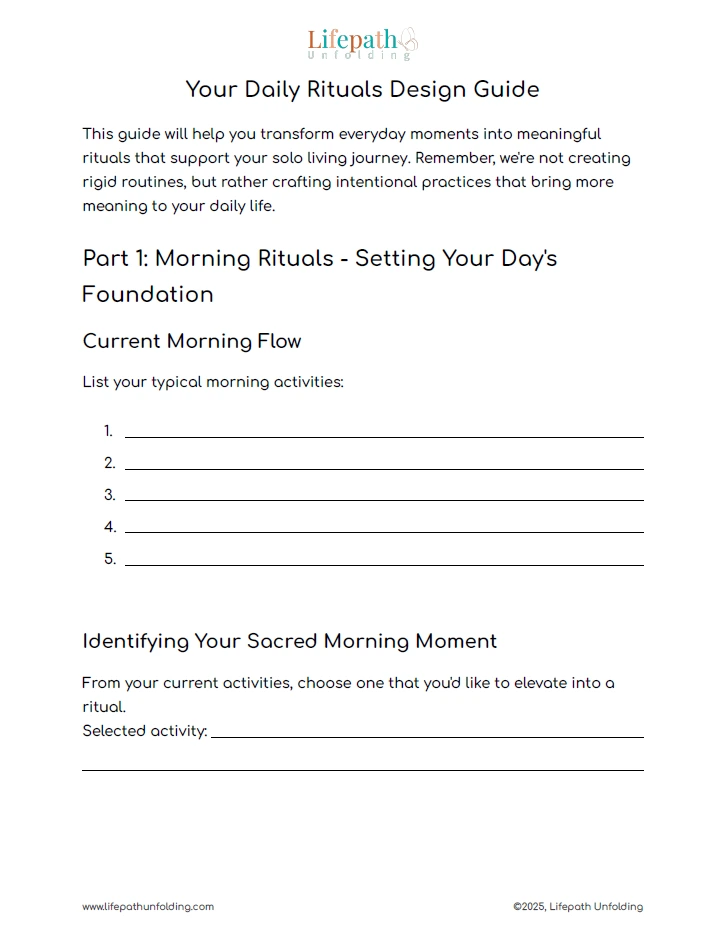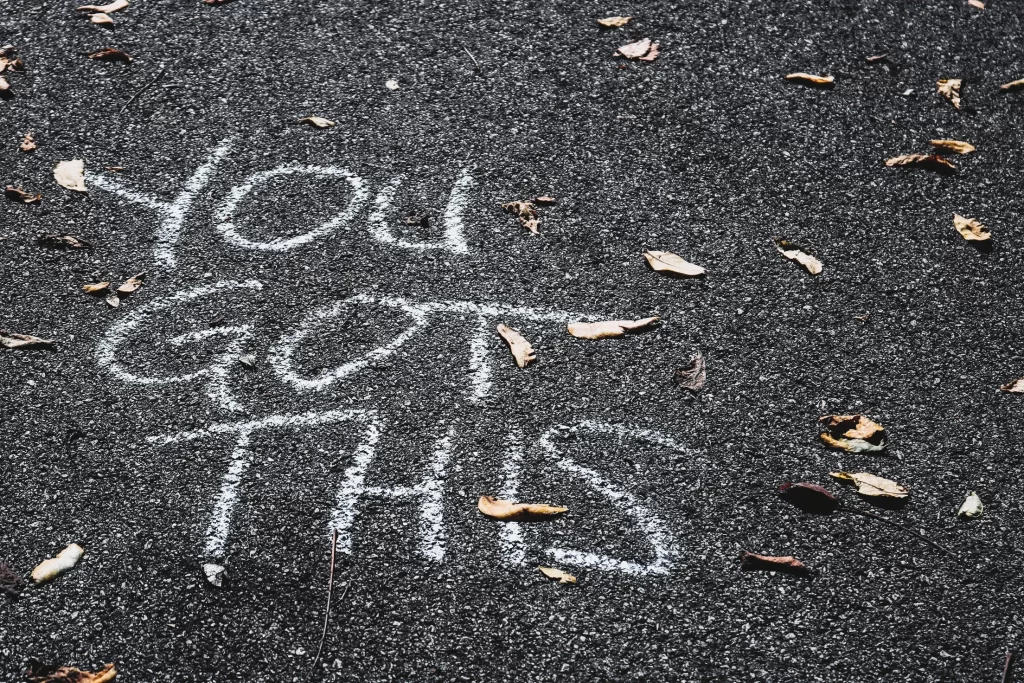Building Daily Rituals for Solo Living
A Path to Balance and Intention
When life shifts, and the rhythm of a bustling household quiets down, it can feel disorienting. Suddenly, the familiar structure of shared routines fades, leaving days that feel unanchored. But solo living doesn’t have to feel like an absence — it can be a canvas for intentionality. Your daily rituals can be a grounding force, offering both emotional balance and moments of deeper connection with yourself.
Whether you’re seeking calm after a busy past or aiming for a sense of purpose in the present, nurturing mindful rituals can transform how you experience your day. These rituals, however small, create anchors — allowing you to find stability and joy in a life uniquely your own.
The Reality Check
Building daily rituals for solo living often starts with confronting an unexpected truth: without the daily rhythms of a shared life, you can feel unmoored, like a ship suddenly without a captain. When you transition from the bustling energy of a full household to the quiet of being on your own, there’s an undeniable shift. The absence of external demands can feel freeing, but the limitless space can also feel heavy.
The beauty, however, lies in recognizing that this space is now yours to shape. Still, it’s not uncommon to feel hesitant — where do you even begin? Let’s pause to explore the emotional and practical realities beneath the surface.
Facing the Loss of Structure

For years, the structure of your day may have been tied to caring for others or filling roles that required your constant attention. Without these anchors, it’s natural to feel a sense of loss or even confusion.
But what if we reframe this as an opportunity? This period can be seen not as a void to fill but as a foundation where you intentionally build. The shift from external structure to self-created rhythm is monumental, but it’s worth the effort.
Here’s a helpful mindset: think of creating rituals as planting seeds. Each small action — a morning cup of coffee, a ten-minute walk, or journaling your thoughts — is a seed that grows roots, helping to ground you in your own life.
Common Hesitations and How to Address Them
You might wonder, “What if I don’t stick to it?” Or maybe the idea of sitting with your aloneness feels daunting. These hesitations are common and valid. After all, shifting from outward responsibilities to inward exploration is no small task.
The solution? Start small. Focus less on the perfection of the ritual and more on creating it. Even five minutes of purposeful action can reshape the tone of your day. Embracing imperfection and flexibility can help ease the pressure of “getting it right.” Rituals are about resonance, not routine — they’re meant to evolve with you.
Why Rituals Are Transformative
Creating rituals is about more than passing time. They are acts of self-care and personal growth. Rituals bring focus to our days, offering a sense of control and predictability. That’s vital when life feels anything but predictable.
Think of your rituals as a compass. Without one, you might drift through your days. With one, however, you can chart a course aligned with your values, even when circumstances seem uncertain. Over time, these rituals become the rhythm of your life, creating an environment that nurtures rather than drains you.
By planting these deliberate moments into your schedule, you’re not only grounding yourself but also building a life filled with meaning and intention.
Morning: Setting Your Day’s Foundation

The morning often sets the tone for everything that follows. It’s your opportunity to take the reins of the day before the demands of the world pull you in different directions. For solo living, mornings can become a sacred space — a chance to cultivate quiet focus and prepare yourself emotionally, mentally, and physically. When approached mindfully, these early hours transform from rushed routines into grounding rituals.
Difference Between Rushed Routines and Grounding Rituals

In the shuffle of responsibility and habit, many people find themselves rushing through mornings on autopilot. Perhaps it’s brewing coffee while scrolling through emails or impatiently ticking off chores, feeling like you only just made it to the starting line. This hurried pace creates a sense of urgency, leaving you feeling uncentered before the day fully begins.
In contrast, grounding rituals are intentional acts. These are mindful actions that prioritize presence over productivity. They’re not just things you do but how you do them. Think of these rituals as building the foundation of a house — each brick carefully laid, supporting and stabilizing the rest of your day.
Take a moment to reflect: “What energy do you want to bring to your mornings?” Choosing calm, clarity, or even curiosity as your intent can reshape how you approach this pivotal part of the day.
Elevating a Morning Activity into a Ritual
You don’t need a complex schedule to make mornings meaningful. Start with one simple activity you already do and elevate it into a mindful ritual. Perhaps your morning coffee becomes a meditative moment. Rather than sipping it distractedly, sit by a sunny window, feel the warmth of the mug in your hands, and focus on the aroma and taste.
Small adjustments like this turn mundane routines into moments of connection with yourself. When you give your mornings this kind of care, you’ll discover they quietly return the favor throughout the day, providing stability and strength.
Action Step: Create Your Morning Anchor

Now it’s your turn. Choose one activity — whether it’s making tea, watering plants, or simply stretching — and decide how you’ll make it special tomorrow morning. Focus on starting small, consistent, and intentional. You’re not seeking perfection, just a little purpose.
When grounding rituals replace hurried routines, your mornings become a gift to yourself. It’s here that you plant the seeds for a day centered on clarity and intention.
Daily Rhythms: Creating Structure with Flexibility

Life can be unpredictable, and for those navigating solo living, the challenge often lies in finding a rhythm that feels both steady and adaptable. In the absence of external schedules, how do you create your own structure without feeling boxed in? The key lies in balancing routine with flexibility — a dynamic approach that supports you instead of shackling you. Your daily rhythm should feel like a well-fitted glove, not a rigid cage.
When you create a structure that ebbs and flows with your energy levels and needs, it offers stability while still leaving room for spontaneity. This balancing act allows you to honor both your responsibilities and your personal growth. Let’s explore how to design these rhythms thoughtfully.
Why Flexibility is Essential in Structure
Creating a daily structure doesn’t mean planning down to the minute. In fact, trying to rigidly control every aspect of your day can backfire, leaving you feeling overwhelmed and defeated. Instead, think of your rhythm like a well-worn hiking trail — a clear path that guides your journey while still allowing you to pause at scenic overlooks, take unexpected detours to discover hidden treasures, or adjust your pace according to the terrain and your energy.
Here’s the beauty of flexibility: it respects your humanity. Some days you’ll have more energy, focus, or inspiration. Other days might feel slower or more reflective. A flexible structure allows you to pivot gracefully, rather than feeling stuck in a system that no longer serves you.

Download 8-Page
“Your Daily Rituals Design Guide“
Actionable Tips for Structured Flexibility
To create a rhythm that supports your solo living journey, consider the following practices:
- Anchor Your Day with Non-Negotiables
Identify 2-3 daily practices that ground you. These are your constants, no matter what the day holds. It could be your morning routine, a midday walk, or an evening gratitude practice. These touchpoints serve as anchors in your day, providing familiarity and stability. - Honor Your Energy Cycles
Do you feel more focused in the morning or evening? Build your day around your natural energy states. Reserve high-energy tasks for your peak times and save quieter activities for moments when you need to recharge. - Leave Space for the Unexpected
Life rarely goes exactly as planned. Build in buffer time between activities to accommodate interruptions or simply to breathe. This helps you stay adaptable without feeling off-course. - Experiment and Adapt
Your daily rhythm isn’t set in stone. Treat your plan like a living document, open to tweaks and revisions. Reflect regularly: what’s working, and what feels forced? Adjust accordingly.
Finding Your Own Pace
When do you feel most centered in your day? Reflect on moments in your current routine that naturally bring you clarity or peace. Use those insights as a starting point to design a rhythm that feels uniquely yours.
Creating structure with flexibility is like designing a riverbank — it guides the water without restricting its flow. This approach invites ease into your daily life, creating a supportive rhythm that adapts as you evolve.
Evening: Honoring the Day’s Close

Evening rituals are your chance to weave a thread of reflection and gratitude through the final hours of your day. They mark a purposeful transition from activity to rest, providing a gentle rhythm that guides you into the night. By honoring the day’s close, you create space to acknowledge its significance — celebrating small victories, releasing tension, and inviting calm.
For those navigating solo living, evenings can feel particularly unstructured or even lonely. Transforming this time into something meaningful offers not only a sense of closure but also a nurturing embrace for your well-being. Let’s explore how to make evenings both soothing and sacred.
Creating a Soft Transition from Day to Night
Think of your evening as a bridge — a pathway that ushers you from the busyness of the day to the serenity of rest. Without a dedicated ritual, the endless scroll of social media or binge-watching TV can easily take over, leaving you feeling scattered rather than settled.
Crafting a mindful transition doesn’t have to be complex. It’s about choosing intentional actions that signal to your body and mind that it’s time to wind down. Perhaps you dim the lights, play calming music, or light a candle at the same time each evening. These small acts create an atmosphere that invites reflection and rest.
How Do You Want to Feel?

As you prepare for the close of your day, pause to ask yourself: “How do I want to feel as I get ready to rest?” Is it peaceful? Grateful? Restored? By grounding this intention, you begin to shape your evening around what truly matters to you. This single question can act as your guide, helping you prioritize activities that align with your desired state of mind.
For example, if you want to feel peaceful, consider adding a short meditation or a warm bath to your routine. If it’s gratitude, take a few minutes to jot down moments from your day that brought you joy or taught you something valuable.
Designing a Simple Evening Ritual
Keep it uncomplicated. The best evening rituals are those you look forward to, not ones that feel like another chore. Choose one or two grounding activities that resonate with you and make them part of your nightly rhythm.
Here are a few ideas to inspire your evening ritual:
- Journaling: Reflect on the day’s highlights or any lingering thoughts to clear your mind before bed.
- Stretching or Gentle Movement: Release physical tension stored in your body with slow, deliberate motions.
- Mindful Tea or Hot Beverage: Savor the warmth and aroma as you sip intentionally.
- Gratitude Practice: Write down three things you appreciated about your day, no matter how small.
- Reading: Opt for a book or article that nurtures your spirit rather than overstimulating your mind.
Every ritual, no matter how small, is a way of telling yourself you are worth this time of care and attention.
“Your daily rituals are not just routines ~ they’re acts of self-respect that create the foundation for your unfolding path.”
Moving Forward
Making the shift from routine to ritual is a deeply personal journey — one that requires both curiosity and compassion. When you live solo, the responsibility of creating meaning in your day lies entirely with you. While that might initially feel overwhelming, it’s also empowering. You hold the brush, and your life is the canvas. Starting small and leaning into experimentation helps you design rituals that feel not only nurturing but also authentic.
Three Ways to Transform Routines into Rituals

Routines are often tasks we do out of habit, but rituals carry intention — a sense of purpose behind the action. Shifting the focus from “what” you’re doing to “how” and “why” can breathe new energy into your day. Here’s how to begin:
- Infuse an Existing Routine with Meaning
Do you already water your plants each morning or prepare a cup of tea? Bring mindfulness to these moments. Pause for a deep breath, notice the gentle rhythms, and reflect on the life you’re nurturing — whether it’s the greenery on your windowsill or your own well-being. - Create a Sense of Celebration
Rituals can feel celebratory, even small ones. Light a candle at the end of a task or play your favorite song when cooking dinner. These small mental shifts turn mundane tasks into acts of joy and gratitude. - Pair Your Rituals with Intentions
Think about what you want to cultivate in your life — peace, creativity, or connection. Let these be your guide. For example, if you seek calm, incorporate quiet, grounding moments into your day like stretching or listening to soothing music.
Permission to Experiment and Adjust
There’s no one-size-fits-all when it comes to your daily rituals. What works today might evolve as your needs shift. Allow yourself the freedom to experiment. Perhaps you try journaling and realize that you prefer drawing as a reflective practice. Maybe you enjoy an evening meditation but realize over time that a short walk better clears your head.
When you view your rituals as living, breathing practices, they grow with you — adapting and transforming instead of becoming stagnant.
A Reminder: Rituals Are Not Rules

It’s worth emphasizing that rituals aren’t about rigid schedules or perfection. They’re about meeting yourself where you are. There will be days when a ritual feels effortless and rewarding, while other times might feel harder to show up for. Both are okay. This is about creating space for what nurtures you, not adding another layer of obligation.
With a touch of mindfulness and a bit of kindness, you can design rituals that not only serve your life but also illuminate it. Embrace this as a time of discovery — you might be surprised at what resonates and brings you joy.
Rituals shape the way you experience your day, allowing you to create a life that feels intentional and fulfilling. They are moments of self-care, reflection, and connection, giving purpose to your routines and grounding you in your journey of solo living.
Your daily rituals don’t need to be perfect to be meaningful. They simply need to resonate with you, offering structure while leaving space for growth and spontaneity. When approached with an open heart, these small, mindful steps become transformative, carrying you toward a deeper sense of balance and wholeness.
What everyday moment are you ready to make sacred? Share your thoughts and begin designing the rituals that will nurture the life you envision.

